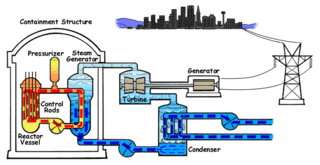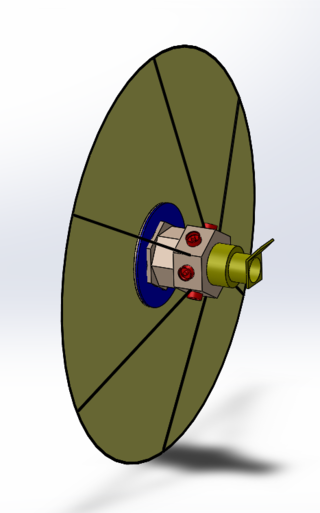
Interstellar travel is the hypothetical travel of spacecraft from one star system, solitary star, or planetary system to another. Interstellar travel is expected to prove much more difficult than interplanetary spaceflight due to the vast difference in the scale of the involved distances. Whereas the distance between any two planets in the Solar System is less than 55 astronomical units (AU), stars are typically separated by hundreds of thousands of AU, causing these distances to typically be expressed instead in light-years. Because of the vastness of these distances, non-generational interstellar travel based on known physics would need to occur at a high percentage of the speed of light; even so, travel times would be long, at least decades and perhaps millennia or longer.
The nuclear salt-water rocket (NSWR) is a theoretical type of nuclear thermal rocket designed by Robert Zubrin. In place of traditional chemical propellant, such as that in a chemical rocket, the rocket would be fueled by salts of plutonium or 20 percent enriched uranium. The solution would be contained in a bundle of pipes coated in boron carbide. Through a combination of the coating and space between the pipes, the contents would not reach critical mass until the solution is pumped into a reaction chamber, thus reaching a critical mass, and being expelled through a nozzle to generate thrust.
Beam-powered propulsion, also known as directed energy propulsion, is a class of aircraft or spacecraft propulsion that uses energy beamed to the spacecraft from a remote power plant to provide energy. The beam is typically either a microwave or a laser beam, and it is either pulsed or continuous. A continuous beam lends itself to thermal rockets, photonic thrusters, and light sails. In contrast, a pulsed beam lends itself to ablative thrusters and pulse detonation engines.
In a traditional nuclear photonic rocket, an onboard nuclear reactor would generate such high temperatures that the blackbody radiation from the reactor would provide significant thrust. The disadvantage is that it takes much power to generate a small amount of thrust this way, so acceleration is very low. The photon radiators would most likely be constructed using graphite or tungsten. Photonic rockets are technologically feasible, but rather impractical with current technology based on an onboard nuclear power source.

A fusion rocket is a theoretical design for a rocket driven by fusion propulsion that could provide efficient and sustained acceleration in space without the need to carry a large fuel supply. The design requires fusion power technology beyond current capabilities, and much larger and more complex rockets.

The Bussard ramjet is a theoretical method of spacecraft propulsion for interstellar travel. A fast moving spacecraft scoops up hydrogen from the interstellar medium using an enormous funnel-shaped magnetic field ; the hydrogen is compressed until thermonuclear fusion occurs, which provides thrust to counter the drag created by the funnel and energy to power the magnetic field. The Bussard ramjet can thus be seen as a ramjet variant of a fusion rocket.

A starship, starcraft, or interstellar spacecraft is a theoretical spacecraft designed for traveling between planetary systems. The term is mostly found in science fiction. Reference to a "star-ship" appears as early as 1882 in Oahspe: A New Bible.

Nuclear pulse propulsion or external pulsed plasma propulsion is a hypothetical method of spacecraft propulsion that uses nuclear explosions for thrust. It originated as Project Orion with support from DARPA, after a suggestion by Stanislaw Ulam in 1947. Newer designs using inertial confinement fusion have been the baseline for most later designs, including Project Daedalus and Project Longshot.

Project Orion was a study conducted in the 1950s and 1960s by the United States Air Force, DARPA, and NASA into the viability of a nuclear pulse spaceship that would be directly propelled by a series of atomic explosions behind the craft. Early versions of the vehicle were proposed to take off from the ground; later versions were presented for use only in space. The design effort took place at General Atomics in San Diego, and supporters included Wernher von Braun, who issued a white paper advocating the idea. Non-nuclear tests were conducted with models, but the project was eventually abandoned for several reasons, including the 1963 Partial Test Ban Treaty, which banned nuclear explosions in space, amid concerns over nuclear fallout.

Nuclear propulsion includes a wide variety of propulsion methods that use some form of nuclear reaction as their primary power source. The idea of using nuclear material for propulsion dates back to the beginning of the 20th century. In 1903 it was hypothesized that radioactive material, radium, might be a suitable fuel for engines to propel cars, planes, and boats. H. G. Wells picked up this idea in his 1914 fiction work The World Set Free. Many aircraft carriers and submarines currently use uranium fueled nuclear reactors that can provide propulsion for long periods without refueling. There are also applications in the space sector with nuclear thermal and nuclear electric engines which could be more efficient than conventional rocket engines.

Laser propulsion is a form of beam-powered propulsion where the energy source is a remote laser system and separate from the reaction mass. This form of propulsion differs from a conventional chemical rocket where both energy and reaction mass come from the solid or liquid propellants carried on board the vehicle.

Project Daedalus was a study conducted between 1973 and 1978 by the British Interplanetary Society to design a plausible uncrewed interstellar probe. Intended mainly as a scientific probe, the design criteria specified that the spacecraft had to use existing or near-future technology and had to be able to reach its destination within a human lifetime. Alan Bond led a team of scientists and engineers who proposed using a fusion rocket to reach Barnard's Star 5.9 light years away. The trip was estimated to take 50 years, but the design was required to be flexible enough that it could be sent to any other target star.

Project Prometheus was established in 2003 by NASA to develop nuclear-powered systems for long-duration space missions. This was NASA's first serious foray into nuclear spacecraft propulsion since the cancellation of the SNTP project in 1995. The project was planned to design, develop, and fly multiple deep space missions to the outer planets.

An interstellar probe is a space probe that has left—or is expected to leave—the Solar System and enter interstellar space, which is typically defined as the region beyond the heliopause. It also refers to probes capable of reaching other star systems.

TAU was a proposed uncrewed interstellar probe that would go to a distance of one thousand astronomical units from the Earth and Sun by the NASA Jet Propulsion Laboratory in 1987 using tested technology. One scientific purpose would be to measure the distance to other stars via stellar parallax. Studies continued into 1990, working with a launch in the 2005–2010 timeframe.
Project Icarus is a theoretical engineering design study aimed at designing a credible, mainly nuclear fusion-based, unmanned interstellar space probe. Project Icarus was an initiative of members of the British Interplanetary Society (BIS) and the Tau Zero Foundation (TZF) started in 2009. The project was under the stewardship of Icarus Interstellar until 2019. It remains a BIS project.

The Enzmann starship is a concept for a crewed interstellar spacecraft proposed in 1964 by Dr. Robert Enzmann. A three million ton ball of frozen deuterium would fuel nuclear fusion rocket engines contained in a cylindrical section behind that ball with the crew quarters. The craft would be about 2,000 feet (600 m) long overall.

Project Dragonfly is the first conceptual design study that assesses the feasibility of a laser-propelled interstellar probe, conducted by the Initiative for Interstellar Studies. Contrary to past unmanned interstellar mission studies such as Project Daedalus and Project Icarus, the focus is particularly on a small spacecraft. The project was founded in 2013 by the Initiative for Interstellar Studies (i4is).

Breakthrough Starshot is a research and engineering project by the Breakthrough Initiatives to develop a proof-of-concept fleet of light sail interstellar probes named Starchip, to be capable of making the journey to the Alpha Centauri star system 4.34 light-years away. It was founded in 2016 by Yuri Milner, Stephen Hawking, and Mark Zuckerberg.













